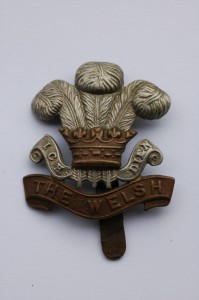This Welsh cap badge was amongst my paternal Grandmothers possessions and given to me when she died.

It must have belonged to Alfred Mansel Young, her brother-in-law, as the name YOUNG has been scratched on the reverse.
This Welsh cap badge was amongst my paternal Grandmothers possessions and given to me when she died.

It must have belonged to Alfred Mansel Young, her brother-in-law, as the name YOUNG has been scratched on the reverse.
Today findmypast released as part of their 100in100 campaign to release 100 record sets in 100 days the largest and most comprehensive collection of British World War 1 service records online, giving family historians a greater chance than ever before of finding their World War 1 ancestors. The newly re-indexed records contain details of millions of the men who fought for their country in one of the largest conflicts in history. As well as a more thorough transcription process which involved an individual examination of over 35 million pages of documentation, findmypast has also identified and indexed lists of names that were tucked away in individual service papers.
The record sets (WO363 and WO64, also colloquially known as the “burnt records”) are all that remain of records caught up in a fire caused by a German incendiary bomb during World War. As only around 40% of the original records survive, the addition of these 600,000 new names taken from extra lists and pages previously not indexed are a real boon to family historians with British military ancestors, as well as to military historians in general.
The records can be searched at http://search.findmypast.co.uk/search-world-Records/british-army-service-records-1914-1920 and are available on all international findmypast sites as part of a world subscription.
I love this little buttonhole brass badge, found amongst the buttons in my grandmother’s button tin. I have no idea who it belonged to.
On War Service 1914
The Admiralty Badge was issued to war workers in shipyards during 1914. In 1916 Admiralty badges were numbered to control their issue amongst the numerous shipyard and related employers.
The 1914 On War Service badge was the first official badge issued during the First World War to identify non-combatant persons whose services were deemed necessary for war work. The badge was issued late 1914 to “workmen whose services are indispensable for the rapid completion of HM Ships and Armaments”.
The issue of this badge to individuals considered essential for war work was left to the shipyards and related employers and if the employee were to cease that employment, the badge had to be handed back.
I think the badge may have belonged to one of my paternal great grandfathers, either George James Benger, who worked in Naval Ordnance in Portsmouth, or Mansel Young who worked as a Dockyard Labourer also in Portsmouth, during the First World War.
Posted in Benger family, First World War, Young family
Tagged badge, Benger, First World War, Portsmouth, Young
Another unusual coin is this small coin stamped 50 HAPA 1915.
On the reverse is the head of Peter I, the King of Serbia, with the words ПЕТАР I. КРАЉ СРБИЈЕ
I believe the coin is silver and was issued in Serbia between 1904 and 1915 and is a 50 PARA.
I would love to believe this coin was collected by my great-uncle whilst he was serving in the Army during the First World War.
The Imperial War Museum are currently asking for help ahead of the launch of Lives of the First World War later this year. They need our help exploring a previously untapped resource which could help them to discover and remember the incredible life stories of the men and women who fought in the First World War.
Operation War Diary, a joint project between IWM and The National Archives, has made digital versions of First World War Unit War Diaries from the Western Front available for the first time. They believe that more people were mentioned by name than previously thought.
You can get involved by becoming a Citizen Historian and help classify some of the 1.5 million pages of unit war diaries which cover activity on the Western Front. There are lots of different types of pages full of fascinating details about the people involved and descriptions of their activities.
From the tags that people add they can create a detailed index to the people who appear in these pages and learn more about what they were doing. Please note they are not transcribing every word of the documents.
This is a great project and will open up lots of sources to the family historian and more importantly allow us to find new mentions of our relatives. Eventually all of the data produced by Operation War Diary will be available to everyone free of charge.
The project also has a blog which I’m sure will be revealing lots of interesting facts as they are discovered.
Next year will be a great year for family historians due to the anniversary of the First World War.
I was excited to learn about a new website – Cymru 1914 – as I have a Welsh ancestor who died during the First World War. According to the homepage:
This project has conducted mass digitization of primary sources relating to the First World War from the Libraries, Special Collections and Archives of Wales. The project will make available a coherent, consolidated digital collection revealing the often hidden history of the First World War as it impacted all aspects of Welsh life, language and culture. This digital archive brings together source materials that were previously fragmented and frequently inaccessible. This digital archive is a unique resource of vital interest to researchers, students, and the public in Wales and beyond.
I haven’t found any mention of my great uncle Alfred Mansel Young yet, but I hope to have some more time to explore the site soon.